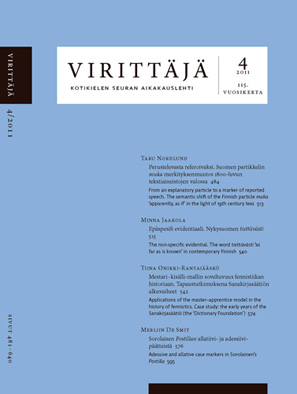Epäspesifi evidentiaali: nykysuomen tiettävästi [The non-specific evidential. The word tiettävästi ‘as far as is known’ in contemporary Finnish]
Abstrakti
Artikkeli kuvaa episteemis-evidentiaalisen partikkelin tiettävästi merkitystä aineistopohjaisesti kognitiivisen kieliopin teoriakehyksessä. Tiettävästi on kirjoitetun kielen elementti, ja aineistona on käytetty Kielipankin neljän sanomalehden otosta. Analyysi perustuu kognitiivisen kieliopin näkemykseen adjektiivikantaisista adverbeista relationaalisina predikaatteina. Tiettävästi ilmaisee kytköstä modaalisen alueen (kiintopiste) ja vaikutusalassaan olevan asiaintilan (muuttuja) välillä. Kiintopiste implikoi modaalisen, tietämistä jäsentävän asteikon, jolle muuttuja jonkin omaisuutensa osalta asetetaan. Partikkelin polysemia perustuu eri kognitiivisten alueiden aktivoitumiseen: evidentiaalinen kognitiivinen alue toimii taustana asteikolle yksilön tiedosta yhteisön tietoon, episteeminen alue taustoittaa asteikkoa kiistämättömästä kiistettävissä olevaan tietoon.
Partikkelin vaikutusalassa, muuttujana, voi olla lauseke tai koko lause. Artikkelissa muuttujan olemusta jäsennetään hyödyntämällä Langackerin (1987) esittämiä jatkumoita konventionaalisen ja ei-konventionaalisen tiedon, geneerisen ja spesifin, luontaisen ja ei-luontaisen sekä luonnehtivan ja ei-luonnehtivan faktan välillä. Aineistossa partikkeli esiintyy erityisesti uutismaisissa juttutyypeissä, ja sen vaikutusalassa on tyypillisimmin spesifi ja ei-konventionaalistunut tieto. Moniäänisemmissä konteksteissa partikkelin vaikutusalassa voi olla myös konventionaalistuneeksi tai geneeriseksi jäsentyvä tieto, jolloin tiettävästi kirvoittaa affektisia tulkintoja.
Partikkelilla voi tuottaa kaksi päinvastaista episteemistä tulkintaa: takauksen (’kuten tiedetään’, ’saadun tiedon mukaan’) tai varauksen (’niin paljon kuin saadun tiedon perusteella tiedetään’). Sanomalehtiteksteissä varaus on korosteisin merkitysulottuvuus, mutta se voi helposti limittyä takauksen merkitykseen: partikkelin vaikutusalassa on usein jokin uutisen yksityiskohta, jonka varmuus konstruoidaan partikkelin merkitystä hyödyntäen siten, että asiaintila on varmaa saadun tiedon perusteella, mutta voi muuttua, mikäli lähteestä saadaan uutta tietoa.
Partikkelin varaus-merkitys nousee referoinnin implikaatiosta, joka puolestaan perustuu epäspesifisyyteen: partikkelilla ei ilmaista tiedon saamisen tapaa, mutta viitataan tiedon olevan jollakin tavalla jaettavissa olevaa eikä vain yksilön tietoa. Artikkelissa referointimerkitystä käsitellään kuitenkin implikaationa, joka on käyttökonteksteissa yleensä mutta ei välttämättä läsnä. Epäspesifinä evidentiaalina partikkelin keskeinen tekstuaalinen funktio on implikoida näkökulman jonkinlaista muutosta tai ilmaista referointilinjasta poikkeavaa ääntä.
---
The non-specific evidential. The word tiettävästi ‘as far as is known’ in contemporary Finnish
This article examines the meanings of the epistemic evidential particle tiettävästi ‘as far as is known’ within the theoretical framework of cognitive grammar (Langacker 1987, 1991, 2008). The analysis is corpus-based. Tiettävästi is an element of written language, and the corpus of texts used here is taken from four newspapers represented in the Language Bank Corpus (maintained by CSC, the IT Centre for Science Ltd). The analysis is based on the notion within cognitive grammar of adjectival adverbs used as relational predicates. Tiettävästi expresses a relation between a modal domain (the landmark of the relation) and the entity functioning as a scope of the particle (the trajector of the relation). The landmark implicates a modal scale representing knowledge, to which the trajector is attached according to some of its properties. The polysemy of the particle has its roots in the activation of different cognitive domains: the evidential cognitive domain operates as the background to the scale from individual knowledge to shared knowledge, while the epistemic domain provides a scale from irrefutable knowledge to knowledge that can be brought into question.
Within the scope of the particle (as a trajector) may be a clause or an entire sentence. The article defines the role of the trajector using Langacker’s (1987) model and the continua from conventional to non-conventional knowledge, from the generic to the specific, from the intrinsic to the extrinsic, and from characteristic to non-characteristic knowledge. In the data used here, the particle appears most frequently in journalistic texts whereby within its scope is a piece of very specific, non-conventionalised knowledge. In more polyphonic contexts the particle may also refer to conventionalised or generic information, whereby tiettävästi would in fact serve to trigger affective interpretations.
The particle can be used to produce two opposing epistemic interpretations: a guarantee (‘as far as we all know’, ‘according to the information at hand’) or a hedge (‘as much as can currently be deduced from the information at hand’). In journalistic texts hedging is the most frequent meaning of the particle, but this can easily overlap with the meaning of the guarantee: within the particle’s scope there is generally a given detail in the news item, the veracity of which is constructed using the particle’s meanings to signify that the nature of the matter is currently certain, based on the knowledge at hand, but that it may change should new information come to light.
The particle’s use for hedging comes from the implication of reported knowledge, which by its very nature is based upon non-specificity: the particle does not explain how the information came about, rather it indicates that the knowledge can be shared and is not specific to one individual. The article also deals with the significance of reported speech as an implication often found in certain usage contexts though not always present. As a non-specific evidential, the particle’s central textual function is to imply a possible change in perspective of or to express opposing voices within the reported speech.






